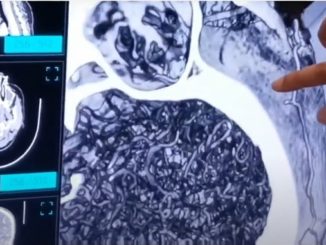
Sponsored article The augmented reality (AR and virtual reality (VR) market is big business – and growing fast. IDC estimates a five-year compound annual growth rate (CAGR) in AR/VR spending of 76.9 percent worldwide in the 2019 – 2024 time period, to reach $136.9 billion by 2024. Multiple drivers are powering this surge in AR/VR demand, the tech analyst firm says, including remote working requirements, contactless business processes, augmented meeting places and virtual social togetherness.[i]
Let’s take a look at some AR/VR use cases in higher education. Higher education institutions are increasingly leveraging AR and VR solutions in classrooms and remote-learning environments – a necessity in these pandemic times. Some of the educational scenarios emphasize the special needs of individual students or distance learning. For example, Texas A&M University and the University of Arkansas at Little Rock are taking AR and VR in directions that incorporate the social aspect of education in technologically enhanced learning environments. At the same time both institutions are running labs that are devoted to the development and enhancement of innovative applications for AR and VR.
Driving VR innovation at Texas A&M
At Texas A&M University, the Visualization Immersive Reality Lab (VIRL) of the Department of Visualization, which is part of the College of Architecture, provides students and faculty with extensive resources for VR exploration and creation. VIRL offers studio space, workstations, head-mounted displays (HMDs), panel displays, software and support.
VR and AR are part of the educational culture and critical enablers of research and special projects in a number of Texas A&M groups and departments. For instance, the university’s Interactive Data and Immersive Environments lab, which is part of the Department of Visualization, uses VR in its human-centered research of interactive visualization.
Elsewhere at Texas A&M, a Learning Interactive Visualization Experience Lab makes use of VR to research and create educational experiences for K–12 and higher education and to enable training in companies, nonprofits and public-sector entities. And all the while, the Immersive Mechanics Visualization Lab in the College of Aerospace Engineering explores VR in the context of data modeling and experiential design. The new Grace supercomputer, powered by Dell Technologies and NVIDIA, will serve as a platform for ground-breaking discoveries and innovations in science and engineering at Texas A&M.
Evolving AR and VR at UA Little Rock
Elsewhere in academia, the University of Arkansas at Little Rock is evolving AR and VR through groundbreaking research and industry partnerships.
The George W. Donaghey Emerging Analytics Center (EAC) at UA Little Rock is the academic home for students, faculty and researchers who use VR, XR (extended reality) and complementary technologies to support data analytics and visualization, create educational and training environments, and develop software architectures for VR and visualization. Part of the EAC’s mission is to take its technology findings to the companies that sponsor and collaborate with it. The EAC explores a great variety of VR and AR scenarios but does not get into gaming or movie animations.
EAC Director Dr. Carolina Cruz-Neira has been a VR pioneer for more than 30 years and has received numerous awards for her work. In the 1990s, Dr. Cruz-Neira created the groundbreaking Cave Automatic Virtual Environment (CAVE) as part of her Ph.D. thesis. She also developed the first clustered software to build CAVE and early VR applications.
In Dr. Cruz-Neira’s view, the synergies between higher education, innovative businesses and technology providers are critical for moving VR and AR forward. In her career, she has repeatedly advanced open-source initiatives to create practical VR and AR technologies that have commercial value.
Collaborating with her VR contacts at Dell Technologies and other organizations, Dr. Cruz-Neira and her EAC teams have also been consulting with school districts and businesses in Arkansas, helping people understand how VR can be of value in educational and commercial environments.
Working with Dell Technologies and NVIDIA
Dell Technologies and NVIDIA have delivered VR-ready technology for many years, often partnering with other industry leaders to enable continuous innovation and standards optimization to evolve the technology. Both universities discussed here deploy Dell Precision workstations with NVIDIA GPUs in their AR and VR production, research and exploration.
In addition, educators, students and researchers enhance their AR and VR practices with the Dell Canvas, a digital creation and collaboration workspace that can be used vertically or horizontally. Precision 7000 Series mobile workstations with NVIDIA GPUs are compatible with the leading head-mounted displays, including the Dell Visor MR and the HTC Vive.
Key takeaways
A surge in interest, innovation and investment in AR and VR is under way in colleges and universities. These immersive technologies, often enhanced by artificial intelligence, are rapidly becoming more powerful and versatile.
Educational institutions are aware of the many innovation opportunities and potentially valuable usage scenarios for these immersive technologies. To that end, they are committing vast resources and creating new curricula and programs to teach and research AR and VR solutions, as well as to put the technologies to work to enhance classroom and remote learning.
For a closer look at AR and VR at Texas A&M University and the University of Arkansas at Little Rock, see the Dell white paper “Expanding the horizons of augmented and virtual reality in higher education.” Also, find out how Medivis uses AR for surgical planning to help improve patient outcomes in the Power of AR and AI in Medical Context.
[i] IDC, “Pandemic Tempers Growth in AR/VR Spending, but the Long-Term Outlook is Positive, says IDC,” July 20, 2020.




Be the first to comment